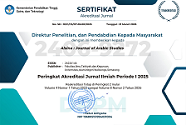A Pragmatic Analysis of Women and Angry Speech: Case Study of The Saudi Arabian Takki Series
DOI:
https://doi.org/10.21580/alsina.7.2.27839Keywords:
Gender Ideology, Impoliteness, Patriarchal Control, Pragmatics, Social DominationAbstract
This study aims to reveal the forms of illocutionary acts and impoliteness strategies in anger utterances directed at women in the Saudi Arabian series Takki. In Arab culture, angry utterances are not merely emotional expressions but serve as tools for enforcing social norms and patriarchal control. This research employs a descriptive qualitative method with a pragmatic approach. The data, consisting of dialogue excerpts, were analyzed using Searle's speech act theory and Culpeper's theory of impoliteness. The results show that anger utterances in Takki are dominated by directive, expressive, commissive, and declarative acts, accompanied by impoliteness strategies, including insults, prohibitions, threats, and verbal abuse. These utterances reflect unequal power relations between men and women and reinforce patriarchal structures in Saudi society. This study confirms that language functions as a significant tool of social control in cultures where family honor is paramount. By uncovering the pragmatic mechanisms that sustain gendered communication hierarchies, this research contributes to the broader understanding of how linguistic behavior reinforces social ideologies within both pragmatic and sociocultural theoretical frameworks.
Downloads
References
Al-Qahtani, Abdulaziz. “Navigating Modernity and Tradition: A CDA of Saudi News Articles on Women’s Rights.” SAGE Open 15, no. 3 (2025): 1–19. https://doi.org/10.1177/21582440251365752.
Alifiansyah, Roby Fathan et al. “Hubungan Kata dan Makna dalam Bahasa Indonesia dan Bahasa Arab: Kajian Semantik.” Alsina : Journal of Arabic Studies 5, no. 1 (2023): 73–92. https://doi.org/10.21580/alsina.5.1.16868.
Anis, Muhammad Yunus. “Bentuk dan Latar Belakang Munculnya Hate Speech dalam Bahasa Arab: Analisis Morfologi dan Pragmatik.” Aksara 32, no. 1 (2020): 119–34. https://doi.org/10.29255/aksara.v32i1.447.119-134.
Austin, J. L. How to Do Things with Words. Oxford: Oxford University Press, 1962.
Berrebbah, Ishak. “Troubled Constructions of Patriarchal and Masculine Identities in Laila Halaby’s West of the Jordan (2003): A Gendered Perspective.” Contemporary Levant 7, no. 2 (2022): 153–66. https://doi.org/10.1080/20581831.2022.2052409.
Culpeper, Jonathan. Impoliteness. Cambridge: Cambridge University Press, 2011. https://doi.org/10.1017/CBO9780511975752.
Culpeper, Jonathan. “Towards an Anatomy of Impoliteness.” Journal of Pragmatics 25, no. 3 (1996): 349–67. https://doi.org/10.1016/0378-2166(95)00014-3.
Dijk, Teun A. van. Discourse and Power: Contributions to Critical Discourse Studies. Houndmills: Palgrave, 2008.
Dwairy, Marwan et al. “Parenting Styles in Arab Societies.” Journal of Cross-Cultural Psychology 37, no. 3 (2006): 230–47. https://doi.org/10.1177/0022022106286922.
Fairclough, Norman. Critical Discourse Analysis: The Critical Study of Language. London: Longman, 1995.
Fairclough, Norman. Language and Power. Harlow: Longman, 1989.
Feghali, Ellen. “Arab Cultural Communication Patterns.” International Journal of Intercultural Relations 21, no. 3 (1997): 345–78. https://doi.org/10.1016/S0147-1767(97)00005-9.
Haziza, Prafitri, and Siti Rohmah Soekarba. “Gender Norm in Saudi Arabia Within Takki The Series Directed By Mohammad Makki.” IJAS: Indonesian Journal of Arabic Studies 5, no. 2 (2023): 123–43. https://doi.org/10.24235/ijas.v5i2.13239.
Husein, Syarif et al. “Illocutionary Speech Acts of Assertive, Directive, Expressive, Commissive, and Declarative in the Tweets of Jibran Kholil Jibran Account.” Arabiyatuna: Jurnal Bahasa Arab 7, no. 2 (2023): 541–62. https://doi.org/10.29240/jba.v7i2.8257.
Hussain, Muhammad et al. “Gender Stereotyping in Family.” Sage Open 5, no. 3 (2015). https://doi.org/10.1177/2158244015595258.
Khoury-Kassabri, Mona, and Asher Ben-Arieh. “School Climate and Children’s Views of Their Rights: A Multi-Cultural Perspective among Jewish and Arab Adolescents.” Children and Youth Services Review 31, no. 1 (2009): 97–103. https://doi.org/10.1016/j.childyouth.2008.06.002.
Leshin, Joseph et al. “Language Access Differentially Alters Functional Connectivity during Emotion Perception across Cultures.” Frontiers in Psychology 14 (2024). https://doi.org/10.3389/fpsyg.2023.1084059.
Nassaji, Hossein. “Good Qualitative Research.” Language Teaching Research 24, no. 4 (2020): 427–31. https://doi.org/10.1177/1362168820941288.
Pebriyanti, Elisa Trisyani et al. “Analisis Tindak Tutur Ilokusi pada Film Animasi Muhammad bin Ka’ab Al-Quradhy: Kajian Pragmatik.” Journal of Linguistic Phenomena 3, no. 2 (2025): 44–48. https://doi.org/10.24198/jlp.v3i2.59638.
Reiland, Indrek. “‘Austin vs. Searle on Locutionary and Illocutionary Acts’’.’” Inquiry, 2024, 1–26. https://doi.org/10.1080/0020174X.2024.2380322.
Rupidara, Indar, and Irwan Suswandi. “Penggunaan Ujaran dalam Mengekspresikan Kemarahan pada Film Penyalin Cahaya karya Wregas Bhanuteja.” Kode : Jurnal Bahasa 12, no. 3 (2023): 17–31. https://doi.org/10.24114/kjb.v12i3.47549.
Sadiqzade, Zarifa. “The Linguistic Expression of Emotion: A Cross-Cultural Analysis.” EuroGlobal Journal of Linguistics and Language Education 2, no. 3 (2025): 42–54. https://doi.org/10.69760/egjlle.2500195.
Saifudin, Akhmad. “Teori Tindak Tutur dalam Studi Linguistik Pragmatik.” LITE: Jurnal Bahasa, Sastra, dan Budaya 15, no. 1 (2019): 1–16. https://doi.org/10.33633/lite.v15i1.2382.
Searle, John R. “A Classification of Illocutionary Acts.” Language in Society 5, no. 1 (1976): 1–23. https://doi.org/10.1017/S0047404500006837.
Srilaksmi, Ida Ayu Alit, and Calvin Damasemil. “The Construction Reality of Women Image as Patriarchal Objects in Indonesian Horror Film.” Jurnal Audience 7, no. 1 (2025): 51–62. https://doi.org/10.33633/ja.v7i1.9905.
Thorsen, Einar, and Chindu Sreedharan. “#EndMaleGuardianship: Women’s Rights, Social Media and the Arab Public Sphere.” New Media & Society 21, no. 5 (2019): 1121–40. https://doi.org/10.1177/1461444818821376.
Yoyo, Yoyo. “Ujaran Kebencian (Khitāb Al-Karāhiyah) dalam Ruang Kontestasi Sosial Politik Arab Kontemporer.” Adabiyyāt: Jurnal Bahasa dan Sastra 3, no. 1 (2019): 120–39. https://doi.org/10.14421/ajbs.2019.03106.
Zhang, Pingfan. “Objectification, Bodily Revenge, and National Identity: Refashioning ‘Comfort Women’ in Chinese Cinema.” Asian Studies Review 48, no. 4 (2024): 727–44. https://doi.org/10.1080/10357823.2023.2289638.
Downloads
Published
How to Cite
Issue
Section
License

This work is licensed under a Creative Commons Attribution-NonCommercial-ShareAlike 4.0 International License.
Copyright
The copyright of the received article shall be assigned to the publisher of the journal. The intended copyright includes the right to publish the article in various forms (including reprints). The journal maintains the publishing rights to published articles. Authors are allowed to use their articles for any legal purposes deemed necessary without written permission from the journal, but with an acknowledgment to this journal of initial publication.
Licensing
In order for Alsina: Journal of Arabic Studies to publish and distribute research articles, the editors need publishing rights (transferred from author to publisher). This agreement relates to the transfer/publishing copyright license to Alsina: Journal of Arabic Studies but the authors still have significant rights to use and share their published articles.
Alsina: Journal of Arabic Studies supports the need for writers to share, disseminate and maximize the impact of their research and their rights on any database. As a journal article writer, you have the right to various uses of your articles, including that by the institution or company where you work. Copyright can be used without the need for special permission. Authors who publish articles in the Alsina: Journal of Arabic Studies have broad rights to use their work for teaching and scientific purposes without requesting permission, including:
- Use by the author for lectures, presentations, or conferences, with distribution of copies to participants;
- Distribution to colleagues for research use;
- Use in compilations of the author's subsequent work;
- inclusion in a thesis or dissertation;
- Reuse of sections or excerpts from articles in other works (with full acknowledgment of the final article);
- Preparation of derivative works (other than commercial purposes) (with full acknowledgment of the final article);
- Voluntary posting on open websites operated by authors’ or writers' agencies for scientific purposes
When submitting a manuscript, authors do so on the understanding that if accepted for publication, the copyright for publishing (publishing right) of the article shall be assigned/transferred to Alsina: Journal of Arabic Studies.
Authors whose articles are accepted for publication will receive confirmation via email and sent a Copyright Transfer Agreement.

 Accreditation
Accreditation 
 In Collaboration with
In Collaboration with 

 Visitors
Visitors  Article Template
Article Template





